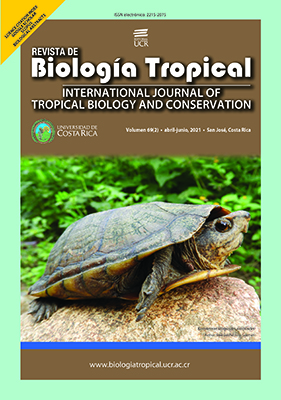Abstract
Introduction: Spondias tuberosa is a tree endemic to the semiarid region of Brazil with fruticulture potential. Objective: To estimate the diversity and genetic structure of S. tuberosa accessions from four areas of the semiarid region of Brazil, in order to facilitate conservation genetic resources studies in this species. Methods: DNA was extracted, using the CTAB 2x method, from leaf samples of 24 accessions of S. tuberosa available in the germplasm bank at Embrapa Semiárido, Brazil. Ten microsatellite loci were used in this study. Results: The UPGMA dendrogram, generated with a Jaccard coefficient similarity matrix, contains four groups at a 0.44 cutoff point. The similarity coefficient ranged from 0.30 to 0.84, indicating great divergence among the accessions. A Bayesian analysis conducted with the software Structure suggests there are two subpopulations, one formed by accessions from the Januária region and another by accessions from the Juazeiro, Uauá and Petrolina regions. The ΦST value of 0.12 for the analysis of molecular variance indicates moderate genetic differentiation among the four populations, suggesting that the genetic variability is moderately structured in function of region. Conclusions: Together, the analyses indicate that the genetic diversity of S. tuberosa is not uniformly distributed in the studied regions. Thus, germplasm from a greater number of populations should be collected to increase the germplasm bank genetic diversity of the species.
References
Aguilar-Barajas, E., Sork, V.L., González-Zamora, A., Rocha-Ramírez, V., Arroyo-Rodríguez, V., & Oyama, K. (2014). Isolation and characterization of polymorphic microsatellite loci in Spondias radlkoferi (Anacardiaceae). Applications in Plant Sciences, 2(11), 1400079.
Balbino, E., Caetano, B., & Almeida, C. (2018). Phylogeographic structure of Spondias tuberosa Arruda Câmara (Anacardiaceae): seasonally dry tropical forest as a large and continuous refuge. Tree Genet Genomes, 14(5), 1-8.
Balbino, E., Martins, G., Morais, S., & Almeida, C. (2019). Genome survey and development of 18 microsatellite markers to assess genetic diversity in Spondias tuberosa Arruda Câmara (Anacardiaceae) and cross-amplification in congeneric species. Molecular Biology Reports, 46(3), 3511-3517.
Botstein, D., White, R.L., Skolnick, M., & Davis, R.W. (1980). Construction of a genetic linkage map in man using restriction fragment length polymorphisms. American Journal of Human Genetics, 32(3), 314-331.
Costa, S.R., & Santos, C.A.F. (2013). Allelic database and divergence among Psidium accessions by using microsatellite markers. Genetics and Molecular Research, 12(4), 6802-6812.
Costa, S.R., & Santos, C.A.F. (2017). Genetic divergence among Psidium accessions based on single nucleotide polymorphisms developed for Eucalyptus. Genetics and Molecular Research, 16(2), gmr16029566.
Creste, S., Neto, A.T., & Figueira, A. (2001). Detection of single sequence repeat polymorphisms in denaturing polyacrylamide sequencing gels by silver staining. Plant Molecular Biology Reporter, 19(4), 299-306.
Cristóbal-Pérez, E.J., Fuchs, E.J., Harvey, N., & Quesada, M. (2019). Isolation and characterization of microsatellites loci in Spondias purpurea (Anacardiaceae) and cross amplification in congeneric species. Molecular Biology Reports, 46(5), 5581-5585.
Doyle, J.J., & Doyle, J.L. (1990). Isolation of plant DNA from fresh tissue. Focus, 12(13), 39-40.
Earl, D.A., & vonHoldt, B.M. (2012). STRUCTURE HARVESTER: A website and program for visualizing STRUCTURE output and implementing the Evanno method. Conservation Genetics Resources, 4(2), 359-361.
Evanno, G., Regnaut, S., & Goudet, J. (2005). Detecting the number of clusters of individuals using the software STRUCTURE: A simulation study. Molecular Ecology, 14(8), 2611-2620.
Excoffier, L., Smouse, P.E., & Quattro, J.M. (1992). Analysis of molecular variance inferred from metric distances among DNA haplotypes: Application to human mitochondrial DNA restriction data. Genetics, 131(2), 479-491.
Meirmans, P.G., & Hedrick, P.W. (2011). Assessing population structure: FST and related measures. Molecular Ecology Resources, 11(1), 5-18.
Paiva, J.R. (1998). Melhoramento genético de espécies agroindustriais na Amazônia: estratégias e novas abordagens. Fortaleza, CE: Embrapa-CNPAT.
Peakall, R.O.D., & Smouse, P.E. (2006). GENALEX 6: genetic analysis in Excel. Population genetic software for teaching and research. Molecular Ecology Notes, 6(1), 288-295.
Pires, M.D.G.D.M. (1990). Estudo taxonômico e área de ocorrência de Spondias tuberosa Arr. Cam. (umbuzeiro) no Estado de Pernambuco-Brasil (Dissertação de Mestrado). Universidade Federal Rural de Pernambuco, Recife, PE, Brasil.
Pritchard, J.K., Stephens, M., & Donnelly, P. (2000). Inference of population structure using multilocus genotype data. Genetics, 155(2), 945-959.
Ramos, S., Queiroz, M.D., Romão, R.L., & Silva Júnior, J.D. (2008). Germoplasma vegetal conservado no nordeste brasileiro: situação atual, prioridades e perspectivas. Magistra, Cruz das Almas, 20(3), 205-319.
Rohlf, F.J. (2000). NTSYS-pc numerical taxonomy and multivariate analysis system (Version 2.10). Setauket: Exeter Software.
Santana, I.B.B., Oliveira, E.J.D., Soares Filho, W.D.S., Ritzinger, R., Amorim, E.P., Costa, M.A.P.D.C., & Moreira, R.F.C. (2011). Variabilidade genética entre acessos de umbu-cajazeira mediante análise de marcadores ISSR. Revista Brasileira de Fruticultura, 3(3), 868-876.
Santos, C.A.F. (1997). Dispersão da variabilidade fenotípica do umbuzeiro no semi-árido brasileiro. Pesquisa Agropecuária Brasileira, 32(9), 923-930.
Santos, C.A.F., Rodrigues, M.A., & Zucchi, M.I. (2008). Variabilidade genética do umbuzeiro no Semi-Árido brasileiro, por meio de marcadores AFLP. Pesquisa Agropecuária Brasileira, 43(8), 1037-1043.
Silva, B.M., Rossi, A.A.B., Tiago, A.V., Schmitt, K.F.M., Dardengo, J.F.E., & Souza, S.A.M. (2017). Genetic diversity of Cajazeira (Spondias mombin L.) in three geographic regions. Genetics and Molecular Research, 16(1), gmr16018946.
Silva, E.F.D., Martins, L.S.S., & Oliveira, V.R.D. (2009). Diversity and genetic structure in caja tree (Spondias mombin L.) populations in Northeastern Brazil. Revista Brasileira de Fruticultura, 31(1), 171-181.
Silva, S.M., & Alves, R.E. (2008). Desenvolvimento e fisiologia da maturação de frutos do gênero Spondias. In I.E. Lederman, J.S.D. Lira Júnior, & J.F.D. Silva Júnior (Eds.), Spondias no Brasil: umbú, cajá e espécies afins (pp. 23-33). Recife, Brasil: Empresa Pernambucana de Pesquisa Agropecuária, IPA/UFRPE.
Turchetto-Zolet, A.C., Turchetto, C., Zanella, C.M., & Passaia, G. (2017). Marcadores Moleculares na Era Genômica: Metodologias e Aplicações. Ribeirão Preto, São Paulo: Sociedade Brasileira de Genética.
Wright, S. (1949). Genetical structure of populations. Annals of Eugenics, 15(1), 323-354.
Wright, S. (1965). The interpretation of population structure by F-statistics with special regard to systems of mating. Evolution, 19(3), 395-420.
##plugins.facebook.comentarios##

This work is licensed under a Creative Commons Attribution 4.0 International License.
Copyright (c) 2021 Viviane Nunes dos Santos, Carlos Antônio Fernandes Santos, Viseldo Ribeiro de Oliveira, Antonio Elton Da Silva Costa, Fabricio Francisco Santos da Silva



